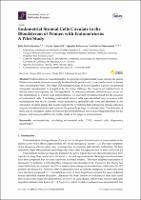| dc.contributor | Vall d'Hebron Barcelona Hospital Campus |
| dc.contributor.author | Vallvé Juanico, Júlia |
| dc.contributor.author | López Gil, Carlos |
| dc.contributor.author | Ballesteros, Agustín |
| dc.contributor.author | Santamaria Costa, Xavier |
| dc.date.accessioned | 2020-02-19T11:36:31Z |
| dc.date.available | 2020-02-19T11:36:31Z |
| dc.date.issued | 2019-07-31 |
| dc.identifier.citation | Vallvé-Juanico J, López-Gil C, Ballesteros A, Santamaria X. Endometrial Stromal Cells Circulate in the Bloodstream of Women with Endometriosis: A Pilot Study. Int J Mol Sci. 2019 Jul 31;20(15):e3740. |
| dc.identifier.issn | 1422-0067 |
| dc.identifier.uri | https://hdl.handle.net/11351/4657 |
| dc.description | Endometriosis; Circulating endometrial cells; CD10 |
| dc.description.abstract | Endometriosis is characterized by the presence of endometrial tissue outside the uterus. While endometriotic tissue is commonly localized in the pelvic cavity, it can also be found in distant sites, including the brain. The origin and pathophysiology of tissue migration is poorly understood; retrograde menstruation is thought to be the cause, although the presence of endometrium at distant sites is not explained by this hypothesis. To determine whether dissemination occurs via the bloodstream in women with endometriosis, we analyzed circulating blood for the presence of endometrial cells. Circulating endometrial stromal cells were identified only in women with endometriosis but not in controls, while endometrial epithelial cells were not identified in the circulation of either group. Our results support the hypothesis that endometrial stromal cells may migrate through circulation and promote the pathophysiology of endometriosis. The detection of these cells in circulation creates avenues for the development of less invasive diagnostic tools for the disease, and opens possibilities for further study of the origin of endometriosis. |
| dc.language.iso | eng |
| dc.publisher | MDPI |
| dc.relation.ispartofseries | International Journal of Molecular Sciences;20(15) |
| dc.rights | Attribution 4.0 International |
| dc.rights.uri | http://creativecommons.org/licenses/by/4.0/ |
| dc.source | Scientia |
| dc.subject | Endometriosi |
| dc.subject | Biòpsia |
| dc.subject.mesh | Endometriosis |
| dc.subject.mesh | Liquid Biopsy |
| dc.title | Endometrial Stromal Cells Circulate in the Bloodstream of Women with Endometriosis: A Pilot Study |
| dc.type | info:eu-repo/semantics/article |
| dc.identifier.doi | 10.3390/ijms20153740 |
| dc.subject.decs | endometriosis |
| dc.subject.decs | biopsia líquida |
| dc.relation.publishversion | https://www.mdpi.com/1422-0067/20/15/3740# |
| dc.type.version | info:eu-repo/semantics/publishedVersion |
| dc.audience | Professionals |
| dc.contributor.authoraffiliation | [Vallvé-Juanico J] Servei de Medicina Reproductiva, IVIRMA-Barcelon, Barcelona, Spain. Recerca Biomèdica en Ginecologia, Vall d’Hebron Institut de Recerca (VHIR), Barcelona, Spain. Hospital Universitari Vall d’Hebron, Barcelona, Spain. Center for Reproductive Sciences, Department of Obstetrics, Gynecology and Reproductive Sciences, University of California, USA. [López-Gil C] Recerca Biomèdica en Ginecologia, Vall d’Hebron Institut de Recerca (VHIR), Barcelona, Spain. Hospital Universitari Vall d’Hebron, Barcelona, Spain. [Ballesteros A] Servei de Medicina Reproductiva, IVIRMA-Barcelona, Barcelona, Spain. [Santamaria X] Servei de Medicina Reproductiva, IVIRMA-Barcelona, Barcelona, Spain. Recerca Biomèdica en Ginecologia, Vall d’Hebron Institut de Recerca (VHIR), Barcelona, Spain. Hospital Universitari Vall d’Hebron, Barcelona, Spain. Igenomix Foundation, Paterna, Spain |
| dc.identifier.pmid | 31370190 |
| dc.identifier.wos | 000482383000133 |
| dc.rights.accessrights | info:eu-repo/semantics/openAccess |

